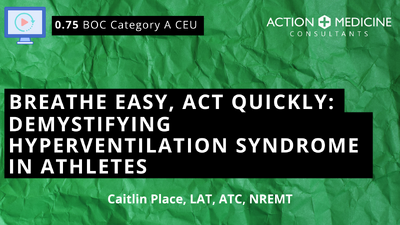Course Info (BOC Domains of Athletic Training; Presentation Description; Learning Objectives; Clinical Practice Gap Statement; Clinical Bottom Line)
BOC Domains of Athletic Training:
- Domain II - Assessment, Evaluation and Diagnosis
- Domain III - Critical Incident Management
- Domain IV - Therapeutic Interventions
Presentation Description:
This session explores hyperventilation syndrome in athletes, focusing on its identification, assessment, and management. Athletic trainers will learn how to recognize the signs and symptoms of hyperventilation syndrome, differentiate it from other respiratory conditions, and apply effective techniques to manage it in high-pressure sports environments. Real-world examples and scenario-based training will be used to enhance practical understanding and improve emergency care.
Learning Objectives:
- Recognize the distinguishing features of hyperventilation syndrome in athletes and understand its underlying causes.
- Apply effective scene safety checks and utilize the OPQRST approach for a comprehensive secondary assessment in emergency situations.
- Review effective breathing regulation techniques and other calming strategies to help athletes recover from hyperventilation.
Clinical Practice Gap Statement:
Despite the prevalence of hyperventilation syndrome in high-pressure sports environments, many athletic trainers lack comprehensive training in recognizing and managing this condition. This session aims to address this gap by providing practical knowledge and scenario-based training, enabling trainers to quickly assess and effectively manage athletes exhibiting hyperventilation symptoms.
Clinical Bottom Line Statement:
Hyperventilation syndrome, often related to anxiety or high-stress environments, can be alarming but is typically benign with proper management. Athletic trainers must be equipped to identify, assess, and calm athletes experiencing this condition while ruling out more severe underlying causes.
Summary Conclusions:
- Hyperventilation syndrome is often linked to high-stress sports environments and can be addressed through calming techniques and breathing regulation.
- Differentiating hyperventilation syndrome from other respiratory conditions requires a thorough assessment, including scene safety checks, OPQRST, and secondary assessment.
- Implementing proper breathing techniques and calming strategies can help athletes recover from hyperventilation quickly.
- Effective communication and eye contact are key to calming athletes experiencing hyperventilation.
- If hyperventilation persists or is accompanied by other concerning symptoms, seek further medical assistance.


